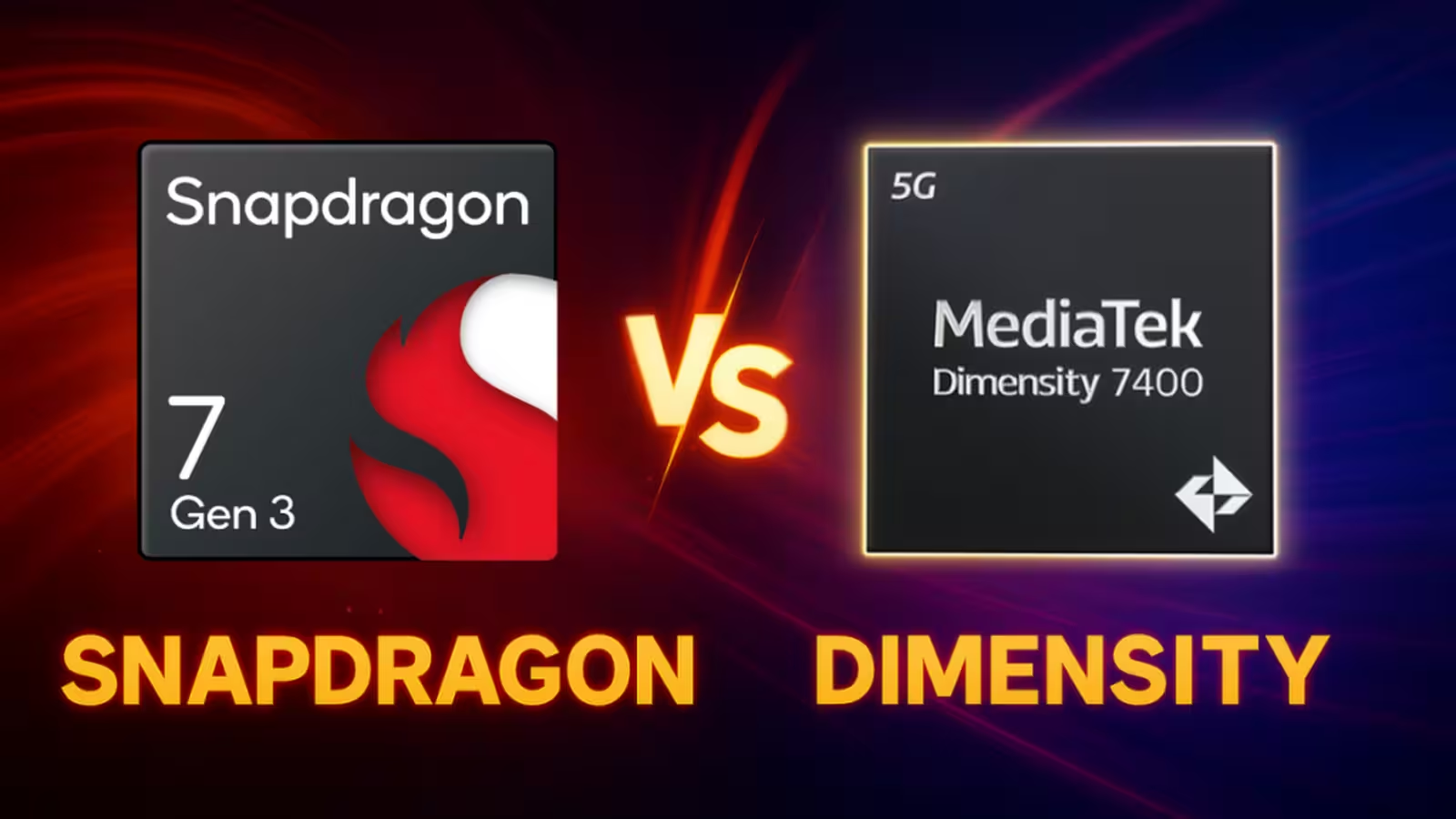7 Minutes
Snapdragon 7 Gen 3 vs Dimensity 7400: The Battle for Mid-Range Supremacy
The competition among mid-range smartphone processors has intensified dramatically, with chipmakers introducing ever more advanced solutions that blur the lines between affordability and flagship performance. Today, we're diving deep into two of the most talked-about contenders on the global market: the Snapdragon 7 Gen 3 from Qualcomm and MediaTek's Dimensity 7400. From benchmark ratings to real-life features, discover which processor delivers superior value for power users, gamers, and everyday smartphone enthusiasts.
Spec Sheet Comparison: Snapdragon 7 Gen 3 and Dimensity 7400
Both chipsets are built using cutting-edge 4nm process technology by TSMC, promising enhanced efficiency and powerful performance. Yet, their architectures and integrated features set them apart:
| Snapdragon 7 Gen 3 | Dimensity 7400 |
|---|---|
| Announced: Nov 2023 | Announced: Feb 2025 |
| CPU: 1×2.63 GHz (Cortex-A715) 3×2.4 GHz (Cortex-A715) 4×1.8 GHz (Cortex-A510) | 4×2.6 GHz (Cortex-A78) 4×2.0 GHz (Cortex-A55) |
| GPU: Adreno 720 | GPU: Mali-G615 MP2 |
| NPU: Qualcomm Hexagon | NPU: MediaTek NPU 655 |
| RAM: LPDDR5, up to 3.2GHz | RAM: LPDDR5, up to 3.2GHz |
| Camera ISP: Spectra Triple ISP (12-bit), up to 200MP, 4K recording | Camera ISP: Imagiq 950 (12-bit), up to 200MP, 4K recording |
| Connectivity: Snapdragon X63 5G (mmWave & sub-6GHz), Wi-Fi 6E (2.9Gbps), Bluetooth 5.4 | Connectivity: MediaTek 5G (sub-6GHz), Wi-Fi 6E, Bluetooth 5.4 |
Benchmark Faceoff: Numbers That Matter
A closer look at benchmark results reveals key performance insights:
AnTuTu Performance
In the widely respected AnTuTu benchmark, the Snapdragon 7 Gen 3 comes out swinging with an impressive score of 819,655, outperforming the Dimensity 7400’s 694,362 by a robust margin of about 18%. The most pronounced advantage is seen in CPU and GPU scores:
- CPU: Snapdragon 269,334 vs. Dimensity 209,325 (29% advantage for Snapdragon)
- GPU: Snapdragon 256,584 vs. Dimensity 172,706 (nearly 49% higher for Snapdragon)
These numbers translate to notably smoother gameplay, snappier graphics rendering, and faster multitasking for Snapdragon-powered devices.
Where the Dimensity 7400 edges ahead is in memory and UX scores, indicating slightly superior RAM management and a more responsive day-to-day user experience:
- Memory: Dimensity 138,293 vs. Snapdragon 129,961
- UX: Dimensity 174,038 vs. Snapdragon 163,776
Geekbench Results
On Geekbench, the differences are more nuanced. The Snapdragon 7 Gen 3 again leads in both single-core (1,154 vs. 1,052) and multi-core (3,018 vs. 2,981) scores, indicative of slightly superior processing muscle for demanding apps and multitasking. Though the Delta is subtle, it starts to show in more intensive tasks and sustained workloads.
| Snapdragon 7 Gen 3 | Dimensity 7400 |
|---|---|
| Single Core: 1,154 | Single Core: 1,052 |
| Multi Core: 3,018 | Multi Core: 2,981 |
Delving Deeper: Architecture, AI, Camera, and Connectivity
CPU & GPU Architecture
The Snapdragon 7 Gen 3 brings the advantage of a modern ARMv8.6-A CPU design, utilizing four powerful Cortex-A715 cores paired with efficient Cortex-A510 cores. By contrast, the Dimensity 7400 relies on an older ARMv8.2-A design, combining Cortex-A78 and Cortex-A55 clusters. This technical edge helps Snapdragon achieve better efficiency and responsiveness, especially for performance-heavy workloads.
Graphics capability is another highlight, with the Adreno 720 GPU in the Snapdragon 7 Gen 3 packing significantly more shading units compared to the Mali-G615 MP2 found in the Dimensity 7400. For gamers or those editing media on-the-go, this means better frame rates and richer visuals in everyday use.
Both processors include robust NPUs for AI-powered tasks, accelerating real-time enhancements in photography, voice features, and power management.
AI and Camera Innovations
Camera quality is a major deciding factor for smartphone buyers, and both chipsets deliver. The Snapdragon 7 Gen 3 boasts the Spectra triple ISP, bringing support for ultra-high-resolution sensors (up to 200MP), 4K video capture, and computational imaging features. AI-driven enhancements include smart low-light processing, real-time object detection, AI remosaic, and advanced noise reduction.
MediaTek’s Dimensity 7400, equipped with the Imagiq 950 ISP, also supports a 200MP camera and 4K recording. Standout features include hardware-accelerated multi-frame noise reduction (MCNR), electronic image stabilization, and advanced AI functions for auto-focus and auto-exposure, ensuring sharp, vibrant images across various scenarios.
5G, Wi-Fi, and Connectivity Strengths
Whether you're a streaming enthusiast, remote worker, or avid gamer, network capabilities are crucial. The Snapdragon 7 Gen 3 has a clear upper hand with its X63 modem: it supports both mmWave and sub-6GHz 5G, delivering peak download speeds up to 5 Gbps (vs. 3.27 Gbps on the Dimensity 7400, which offers sub-6GHz 5G only). With broader frequency support and Wi-Fi 6E (up to 2.9 Gbps) alongside Bluetooth 5.4, the Snapdragon chip is well-positioned for global, future-proof usage, especially in the US and regions offering mmWave coverage.
Despite lacking mmWave, the Dimensity 7400 holds its own with solid sub-6GHz performance, strong Wi-Fi 6E, and the latest Bluetooth standards, perfect for those who may not need bleeding-edge network speeds but still value robust connectivity.
Everyday Performance: Use Cases and Market Relevance
Snapdragon 7 Gen 3 shines for mobile gamers, multitaskers, and power users seeking top-tier mid-range phones with future-ready features—think real-time content editing, competitive online gaming, and fast AI-driven photo processing. Its superior graphics and connectivity make it especially appealing in markets prioritizing mmWave 5G.
Meanwhile, the Dimensity 7400 targets users looking for balanced all-around performance with excellent efficiency. Its better memory and UX benchmarks suggest responsive multitasking and fewer slowdowns in everyday use. For many buyers in Asia and Europe—where sub-6GHz 5G dominates—it’s a compelling, power-efficient choice that doesn’t sacrifice essential features for savings.
Verdict: Which Chipset Should You Choose?
Ultimately, the choice is guided by your priorities:
- Choose Snapdragon 7 Gen 3 if you want the best gaming performance, the latest connectivity (including mmWave 5G), and superior CPU/GPU power for intensive apps.
- Choose Dimensity 7400 if you value balanced daily performance, excellent efficiency, and want a strong user experience at a potentially more affordable price point.
Top Smartphones Powered by Each Chipset
- Snapdragon 7 Gen 3: OnePlus Nord CE 4, Vivo T3 Pro, Vivo V50, Motorola Edge 50 Pro
- Dimensity 7400: Realme Narzo 80 Pro, Motorola Edge 60, Motorola Edge 60 Fusion
Conclusion: Value and Innovation in the Mid-Range Market
Both the Snapdragon 7 Gen 3 and Dimensity 7400 demonstrate just how rapidly mid-tier mobile processors have advanced, packing high-end experiences into more accessible devices. While Snapdragon edges ahead for enthusiast performance and network flexibility, Dimensity 7400’s blend of user-centric speed and power savings makes it a star for practical, everyday use. Whichever you select, you’re tapping into the next generation of connected, AI-powered smartphones.



Comments